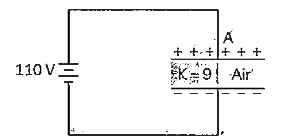Capacitance of a capacitor A, when a dielectric is placed between the capacitor then charged to potential difference 110V is?

The correct Answer is:A
Here, area of the plates of capacitor A,
Area of the plates of capacitor B,
Separation between the plates of the two capacitors,
Suppose C. and C.. is the capacitor of two parts of capacitor A. The total capacitance will be given by
SInce it follows that
Topper's Solved these Questions
- SAMPLE PAPER 6BOOK - EDUCART PUBLICATIONCHAPTER - SAMPLE PAPER 6EXERCISE - Section-C
6 Videos
- SAMPLE PAPER 6BOOK - EDUCART PUBLICATIONCHAPTER - SAMPLE PAPER 6EXERCISE - Section-C
6 Videos
- SAMPLE PAPER 5BOOK - EDUCART PUBLICATIONCHAPTER - SAMPLE PAPER 5EXERCISE - SECTION - C
6 Videos
- SAMPLE PAPER 7BOOK - EDUCART PUBLICATIONCHAPTER - SAMPLE PAPER 7EXERCISE - SECTION-C
6 Videos
Similar Questions
The separation between the plates of a parallel-plate capacitor of capacitance 2μF is 2mm. The capacitor is initially uncharged. If a dielectric slab of surface area same as the capacitor, thickness 1mm, and dielectric constant 3 is introduced, and then the capacitor is charged to a potential difference difference 100V, the energy stored in the capacitor becomes _______mJ.
View SolutionThe space between the rectangular plates (with sides aandb) of a parallel-plato capacitor (the distance between the plates is l) is filled with a solid dielectric whose dielectric constant is c. The capacitor is charged to a certain potential difference and disconnected from the voltage source. After that the dielectric is slowly moved out of the capacitor, which lTIOanS that the section x not filled with the dielectric gradually increases in size. How wi ll the potential difference between the plates and the surface charge densities on both parts of the capacitor (with and without the dielectric) change in the process?
View Solution
Knowledge Check
Consider these three statements for a capacitor
STATEMENT-1 : Capacitance of a capacitor must increase when a dielectric is inserted in between the capacitor plates.
STATEMENT-2 : Potential differenece across a charged capacitor must increase if a dielectric is inserted in between the capacitor plates.
STATEMENT-3 : Electrostatic energy stored by the capacitor may increase if a dielectric inserted in between the capacitor platesAT F FBF T FCT F TDF T TThe capacitance of a parallel plate capacitor is 16μF. When a glass slab is placed between the plates, the potential difference reduces to 1/8th of the original value. What is dielectric constant of glass ?
A4B8C16D32C,Q,V and U are capacitance, charge, potential difference and energy stored in an isolated parallel 1 plate capacitor respectively. Now a dielectric slab is placed between plates of capacitor, the quantities that decreases
AC,QBC,VCV,UDQ,U
A capacitor of capacitance C1 is charged to a potential V1 , while another capacitor of capacitance C2 is charged to a potential difference V2 . The capacitors are now disconnected from their respective charging batteries and connected in parallel to each other
Find the total energy stored in the two capacitors before they are connected .
View SolutionA capacitor of capacitance C1 is charged to a potential V1 , while another capacitor of capacitance C2 is charged to a potential difference V2 . The capacitors are now disconnected from their respective charging batteries and connected in parallel to each other
Find the total energy stored in the parallel combination of two capacitors.
View SolutionAn air capacitor is charged upto a potential V1. It is connected in parallel to an identical uncharged capacitor filled with a dielectric medium. After redistribution of charge if the potential difference of this combination is V, then the dielectric constant of the substance will be
View SolutionAn unchanged capacitor with a solid dielectric is connected to a similar air capacitor charged to a potential of V0.. If the common potential after sharing of charges becomes V, then the dielectric constant of the dielectric must be
View SolutionA dielectric slab is placed between the plates of a parallel plate capacitor. Its capacitance
View Solution
